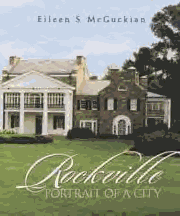
Rockville, Portrait of a City.
Hillsboro Press, Franklin, Tennessee, 2001.
Chapter 4, pp. 57-58.
© City of Rockville
Local Historian
Account
An account by local historian, Eileen McGuckian.
 |
McGuckian, Eileen S. Rockville, Portrait of a City. Hillsboro Press, Franklin, Tennessee, 2001. Chapter 4, pp. 57-58. © City of Rockville |
The Aftermath of War
In addition to two rebel invasions within thirteen months, Rockville's war experience was a series of small incidents of valor, near-misses, poignant encounters, making do, cruelty, and compassion. Citizens took in wounded, exhausted, and hungry soldiers, and slipped food to prisoners being herded through town. They tolerated big city correspondents and opposing hometown papers. The conflict disrupted many Rockville lives and fortunes.
War weary Rockville residents welcomed the end of four years of divisiveness and tension. Whether they chose sides from sentiment, practicality, or ideology, every family had been touched by the lengthy conflict. No household was immune to the anxiety and reality of house searches, high prices, curfews, and nighttime alarms. Foraging troops of both camps took food, horses, and livestock as spoils of war, sharply hurting local farmers. Villagers and nearby farmers were terrified of injury or capture, of losing lives and property, and of being informed on by neighbors.
In Rockville, opposing loyalties coexisted before, during and after the war. They continued each of the multiple times the small town changed hands. although Unionists pointed out Rebels to be imprisoned without trial, and Southrons handed JEB Stuart a list of Union men, Rockvillians of both persuasions used their good offices on behalf of accused, arrested, or mistreated friends. Lifelong neighbors did not require unanimity in order to respect each other or to mourn their sons.
As the town returned to the harmony of daily life, concrete signs of reconciliation--necessitated by the alteration of economic and social conditions through all levels of Rockville society--appeared. Residents resumed the important work of raising children, earning a living, and improving the community. They continued prewar friendships and business relationships, reparied the physical damage, and replaced lost crops and livestock. Citizens united to advance education, physical improvements, town governance, and other community concerns. Recent adversaries such as Richard Johns Bowie and William Veirs Bouic, who had worked together before the war to form the Montgomery County Agricultural Society, after the war united to establish the Rockville Library Association and the Rockville Cemetery Association. Following a turbulent decade in which a generation lost its youth, one-third of the population forged a new identity as it gained freedom, and a legacy of reverence for the lost cause was established. The citizens of Rockville prepared to move on.
Rockville property owners filed a number of claims against damage caused by Federal troops. The Montgomery County Agricultural Society esitmated a cost of nearly $8,300 to rebuild fences, lay out a new race track, repair fields, and reverse four years of use by Union troops. James Anderson, Margaret Beall, and Charles Maddox also filed claims, supported by former Unionist friends and neighbors who confirmed the claimant's loyalty as well as damages incurred.
The crowd which filled the courtroom on the evening of December 6, 1870, demonstrated Rockville's continuing fascination with the war. John H. Surratt, son of the woman hanged for the assassination of Abraham Lincoln, told his version of the plot and its execution to a captive audience. The Washington Star reported "the village deserted of everything save horses and empty vehicles of all kinds" to hear him, but later scolded Surratt for not having attempted to exonerate his mother. John Surratt's trial for complicity in 1867 resulted in a hung jury, after which he taught for a time at the old Montrose School (demolished in 1909) on the Rockville Pike. His Rockville lecture was one of several presented to raise funds to support himself.
Soldier survivors, particularly Confederates, were revered was heroes for the remainder of their lives. Four principals of the Rockville Academy were ex-Rebels. Two, Cooke Luckett and William Pinckney Mason, had been injured while serving the Confederate cause. According to local lore, former Navy Lieutenant Mason, wounded aboard an ironclad boat in early 1865, would rub his leg on damp days and declare "Damn that Yankee!" Locals who frequented the wall in front of the courthouse heard the tales of Edgar Tschiffely, a Southern cavalryman and the last Montgomery County survivor, who died in 1930 at the age of eighty-eight.
Returning veterans formed organizations to maintain connections with their extraordinary experience. The Grand Army of the Republic, formed by Union veterans in 1866, established two posts in Maryland. Although Rockville's Independence Post No. 67 and O.A. Horner Post No. 70 participated in encampments and reunions, no monument to Union soldiers was erected in Montgomery County. Southern veterans formed the Ridgely Brown Camp of teh United Confederate Veterans in 1892, and contributed to the Silver Spring monument erected two years later fr Southerners killed at the Battle of Fort Stevens in 1864. The first goal of the United Daughters of the Confederacy, which formed a chapter in Rockville in 1911, was to erect a monument to Montgomery County soldiers who had fought for the South. The bronze statue was dedicated on June 3, 1913.